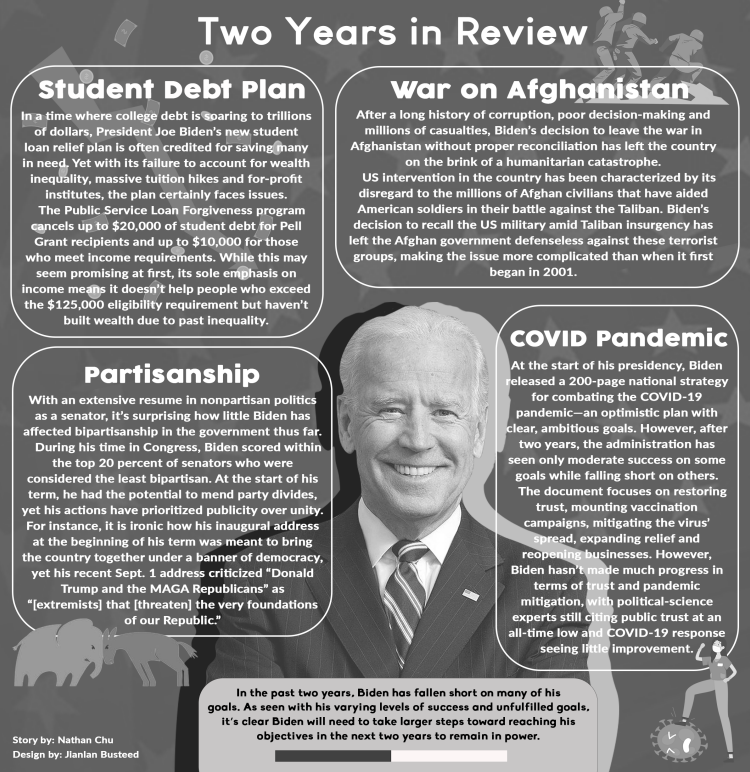Student Loan Debt
In a time where college debt is soaring to trillions of dollars, President Joe Biden’s new student loan relief plan is often credited for saving many in need. Yet with its failure to account for wealth inequality, massive tuition hikes and for-profit institutes, the plan certainly faces issues.
The Public Service Loan Forgiveness program cancels up to $20,000 of student debt for Pell Grant recipients and up to $10,000 for those who meet income requirements. While this may seem promising at first, its sole emphasis on income means it doesn’t address the impact of past discrimination. Many middle-class, low-income POC families who weren’t afforded opportunities to build wealth because of past discrimination are left unable to pay off their debt, even if their income exceeds the $125,000 eligibility for debt cancellation. Overall, this blatant disregard for systemic racism ensures that the policy will never solve the root cause of the issue: profit-oriented institutions and wealth inequality.
War in Afghanistan
After a long history of corruption, poor decision –making and millions of casualties, Biden’s decision to leave the war in Afghanistan without proper reconciliation has left the country on the brink of a humanitarian catastrophe.
US intervention in the country has been characterized by its disregard to the millions of Afghan civilians that have aided American soldiers in their battle against the Taliban. Biden’s decision to recall the US military amid Taliban insurgency has left the Afghan government defenseless against these terrorist groups, making the issue more complicated than when it first began in 2001. Rather, a more moral solution would’ve been to stay and suppress the terrorists until an intra-Afghan peace deal between the Taliban and Ghani government had been negotiated. After all, it’s the least America could have done for these people after leaving them on the verge of collapse.
COVID-19 Pandemic
At the start of his presidency, Biden released a 200-page national strategy for combating the COVID-19 pandemic—an optimistic plan with clear, ambitious goals. Over the past two years since the document was first announced, however, the administration has seen only moderate success on some of its goals while falling short on others.
The document focuses on components such as restoring trust, mounting vaccination campaigns, mitigating the virus’ spread, expanding relief and reopening businesses. However, Biden hasn’t made much progress in terms of trust and pandemic mitigation, with political –science experts still citing public trust at an all –time low and COVID-19 response seeing little improvement. Fortunately, however, the president secured an early win with the American Rescue Plan in March, which allocated $1.9 trillion into direct payments to individuals and small business loans affected by COVID-19. Overall, the Biden administration seems to be doing slightly better than the Trump administration with confronting COVID-19, but they must prepare to take greater action with their national strategy.
Partisanship
With an extensive resume in nonpartisan politics as a senator, it’s surprising how little Biden has affected bipartisanship in the government thus far.
The Lugar Center and PolitiFact reported that during his time in Congress, Biden scored within the top 20 percent of senators who were considered the least bipartisan, cosponsored 40 percent of bills introduced by Republicans and maintained friendships with Republicans such as Mitch McConnell and the late John McCain according to GovTrack. At the start of his term, he had the potential to mend party divides, yet his actions have prioritized publicity over unity. Furthermore, it is ironic how his inaugural address at the beginning of his term was meant to bring the country together under a banner of democracy, yet his recent Sept. 1 address criticized “Donald Trump and the MAGA Republicans” as “[extremists] that [threaten] the very foundations of our Republic.” It’s clear that Biden has made little effort to bring the country together and has only caused a further rift in terms of bipartisanship.
Overall Conclusion
Throughout the past two years, Biden and his administration has fallen short on a majority of the goals they proposed at the start of his presidency. As seen with his varying levels of success and lack of follow-through on some goals, it’s clear that Biden will need to take a larger step toward reaching his objectives over the next two years in order to remain in power.
Your donation will support the student journalists of Diamond Bar High School. Your contribution will allow us to purchase equipment and cover our annual website hosting costs.



